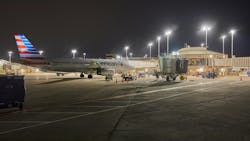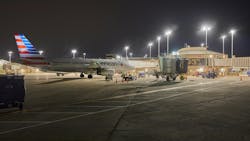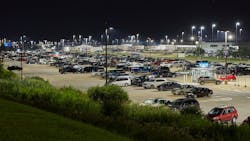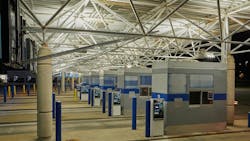Airport Lighting Upgrade Addresses O&M Challenges
Airports’ operations teams face many challenges when it comes to exterior lighting, including energy and maintenance costs, sustainability, safety concerns, parts availability, and lighting performance. For years, Milwaukee Mitchell International Airport (MKE) has been working to lower costs and reduce its environmental footprint. One way the airport is achieving this is by lessening energy usage and improving overall operational efficiency.
Starting with a few exterior LED luminaires previously installed on the electric shop, Dale Hardy, electrical supervisor, MKE, recently moved forward with a large exterior lighting upgrade project to replace all high-intensity discharge (HID) luminaires – metal halide (MH) and high-pressure sodium (HPS) – throughout the grounds (2,180 acres) that are under his jurisdiction. While all of this area isn’t getting a lighting upgrade, Hardy and his team of licensed electricians have been busy installing new luminaires in the area they control.
This project began in mid-summer 2022 and includes 575 LED luminaires installed throughout the tarmac for Concourse D and C; employee, cab, and Remote Lot A parking lots; the MKE Regional Business Park; roadway poles; terminal loading docks; maintenance, fleet, and electrical buildings and poles; the parking structure entrance; and the canopy pay station after exiting the parking structure.
While many factors were driving this project, one of the main issues was the unavailability of replacement parts. “We were having a hard time getting the HID lighting replacement ballasts for the existing fixtures,” Hardy said. “The MH roadway lights no longer had replacement parts available and they told us the lamps are starting to be obsolete, as well.”
This was the perfect reason to look at newer, more efficient technology.
Energy costs
Energy use is a significant percentage of an airport’s operating costs — as much as 10% to 15% of these facilities’ entire operating budget. Upgrading to LED luminaires greatly reduces airports’ energy consumption because, according to the U.S. Department of Energy, they use up to 75% less energy than traditional luminaires.
Energy costs are definitely an issue at MKE. The HID luminaires for the parking lot ranged between 400W to 1,000W. The luminaires around the tarmac were 1,000W MH. The luminaires in the parking lots were 400W HPS. Now, with the new LED luminaires, Hardy anticipates MKE will see an ROI in just a few years and realize reduced lighting energy savings of more than 50%.
Maintenance costs and time
LED luminaires require minimal maintenance. Their solid-state construction makes them resistant to shock, vibrations, and external impacts, ensuring they remain operational even under challenging conditions. As a result, airports can significantly reduce maintenance and labor costs associated with regularly replacing and repairing traditional luminaires.
“The older fixtures or bolts were often rusted and corroded so we couldn’t open them, which increased the time we worked on each fixture,” he said. “Now we're talking about less maintenance in terms of us fixing the lights, particularly during the winter months when it's cold.”
The new exterior luminaires are expected to last 10 years, providing Hardy and his team more time to focus on other airport electrical projects.
Better lighting performance and improved safety
Upgrading to LED luminaires dramatically enhances visibility and improves safety for MKE’s employees, airline personnel, and passengers. The 4000K, 80 CRI area luminaires deliver crisp, white light to the tarmac and offer improved color recognition for security cameras and better night-time visibility for ground personnel.
Before the upgraded lighting was installed, safety was an issue for the airlines and their workers on the tarmac who were moving the baggage carts or handling fuel-servicing operations.
“I’ve received great feedback from ground crews at American, Delta, and Southwest who are benefitting from the reduced glare and more uniform, whiter illumination because it increases visibility and safety,” Hardy said.
Other airport employees, passengers, and airport guests will also benefit from the upgraded roadway, parking lot, and canopy pay station luminaires. Additionally, the new wall packs on buildings throughout the facility deliver advanced light distribution, which provides more visibility for operating partners and airport personnel.
Overall feedback
“This brighter lighting combined with lower energy usage and maintenance costs make these lighting enhancements a win-win for MKE Airport,” says Milwaukee Mitchell International Airport Director Brian Dranzik. “I have received positive feedback from our customers and our tenants who appreciate the higher quality light provided by these upgraded fixtures.”
About the Author
Bob Tortorello
Bob Tortorello is vice president at Wisconsin-based Optec LED Lighting. He can be reached at [email protected]. For more information, visit www.optecledlighting.com.



